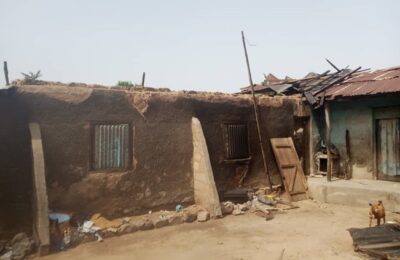Kogi State has continued to battle the challenge of perennial flood disasters with its attendant devastating consequences on the socio-economic wellbeing of the people over the years.
Flooding means when there is an excess overflow of water on land that is normally dry and it can be caused by heavy rainfall, hurricanes or a lack of proper drainage in urban areas where there is little open soil to absorb water.
In 2012, Kogi State witnessed one of the worst flood disasters which led to some deaths, displacement of over 600,000 people and wrecked havoc on farmlands and property.
The flood incident of 2012 which ravaged many communities in the state was mainly blamed on the release of excess water from the Lagdo Dam in Cameroon.
Since that ugly episode, the state has continued to record cases of flood and flash floods across the nine flood prone communities once the rainy seasons set in.
Although a number of factors have been adduced for the recurrent flooding, but one major one is the fact that Kogi State, particularly Lokoja the state capital, happens to be the point where two major rivers – Rivers Niger and Benue – meet.
The River which spans through many communities in the state more often overflows its banks due to increase in the water level thus submerging farmlands and communities.
The water level in the River Niger usually increases beyond the normal level due to heavy rainfall coupled with the water that flow into it from dams, tributaries and other rivers.
Speaking on the recurrent flood situation, the Kogi State Commissioner for Environment and Natural Resources, Usman Yahaya, noted that the state being a confluence point of two rivers made it susceptible to flooding.
“We are always prone to flooding because of the confluence of Rivers Niger and Benue. As it is, water flow from Rivers in Mali and other West Africa countries into the River Niger. Even within the country, water flow from places like Kebbi State.
“The River Benue extends from the Cameroon islands and flow through Adamawa, Taraba, Benue and down to Kogi State.
“On these two major rivers – Niger and Benue – we have dams. Within Nigeria, we have three major dams; Kainji, Jebba and Shiroro. A lot of tributaries of River Niger are draining water into the Niger River.
“And because of the heavy rainfall this year, a lot of water has come into the river from the various tributaries.
“The dams are also filled up and they have to spill excess water so that they do not collapse which would be worse than not releasing the excess water at all.
“With the heavy rainfall and the excess water being spilled every now and then, we down here usually witnessed high elevation of water levels at the River Niger causing it to over flow its bank most of the times.
“The situation is what often leads to flooding of communities, farmlands and property along the bank of the river. The dam in Cameroon has not started spilling water and as soon that happens, it means the water level will go higher.
“In Kogi State, we have nine local government areas that are located along the River Niger and always prone to flooding annually.
“As we speak, all of them have been flooded on different scales but the worst hit is Ibaji local government area which is on the low plains. There’s no upland in that area and so, the place has been submerged.
“Unfortunately like I have explained to you, as long as these dams continue to spill water and coupled with the heavy rainfall, there’s little we can do to stop flooding.
“All we need to do is the awareness and sensitisation campaign on the need for the people to move away from the river banks and flood plains so we don’t have loss of lives,” he said.
Another factor that encourages recurrent flooding is the presence of settlements on flood plains and river banks despite repeated warnings and sensitisation by government on the need to vacate such zones.
It has been observed that those who are often times ravaged by flood disaster in the state are mostly people in communities situated by the riverside or on flood plains.
Most of these inhabitants who live by the riverside and flood plains are predominantly farmers who depend on the water body to earn their living. Such people depend on the river for agriculture and fishing purposes, hence, they would hardly want to vacate such area despite the recurrent flood situation they had faced.
Some of the inhabitants would equally argue that the settlements are their ancestral homes and therefore would not be willing to leave.
Our correspondent gathered that one of the factors that encourage people to acquire land by the river bank and flood plains is the fact that such land are usually sold at cheaper cost compared to the upland.
People who have built their personal houses in such places would not want to leave despite the recurrent flood challenge they face annually.
What most of these people do is to evacuate temporarily once there is flood disaster only to return as soon as the water recedes.
Environmental expert Joseph Athanasius attributed the recurrent flood and flash floods in the state to poor drainage channels, indiscriminate disposal of waste, indiscriminate building of structures on waterways and poor urban planning, amongst others.
“If someone builds on the water way, the possibility is that he will block the water during rainfall thus, causing flooding.
“Another prime cause of flooding is when there are no proper and adequate drainages in the urban cities and towns or sometimes, there could be these drainages but poorly planned,” he said.
On how to tackle the menace of recurrent flood disaster in the state, Mr. Joseph said government should put in place effective flood control measures by ensuring improved drainage channels to allow free flow of water during and after rainfall.
He said flood can also be controlled by building dikes and levees.
“One may wonder what dikes and levees are. These are structures built to control flooding. These structures are built to ensure that they block and control river flooding, including water surges. What these structures do is to block river water and restrain the river any time there is flooding,” he said.
He also identified building of canals and harvesting of excess water from rainfall as other measures that can be used to prevent or control flooding.
Credit: Daily Trust




